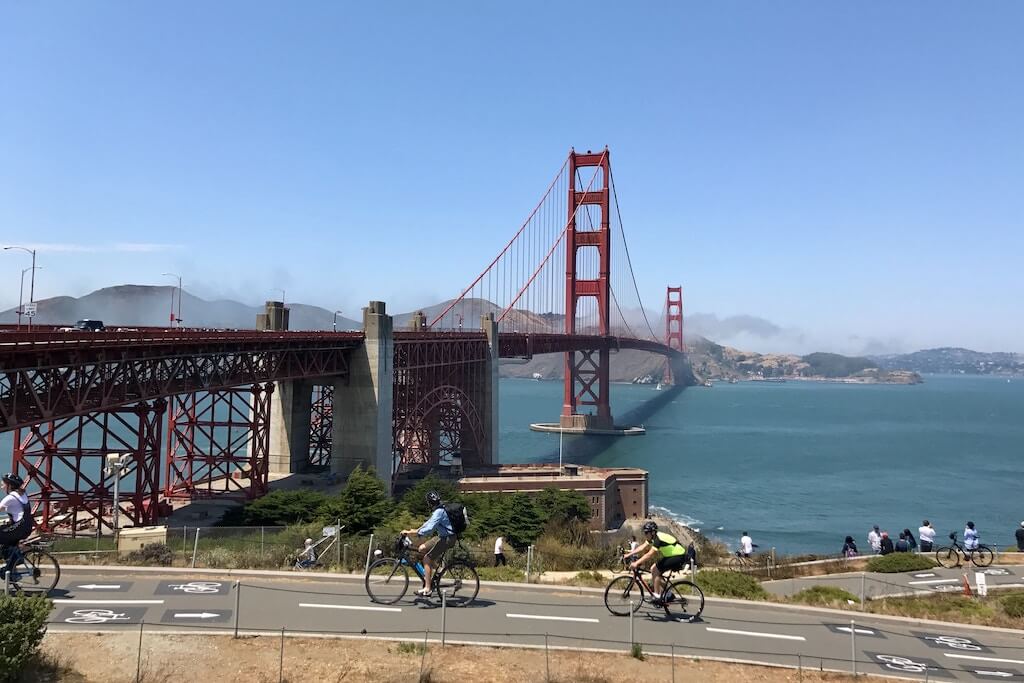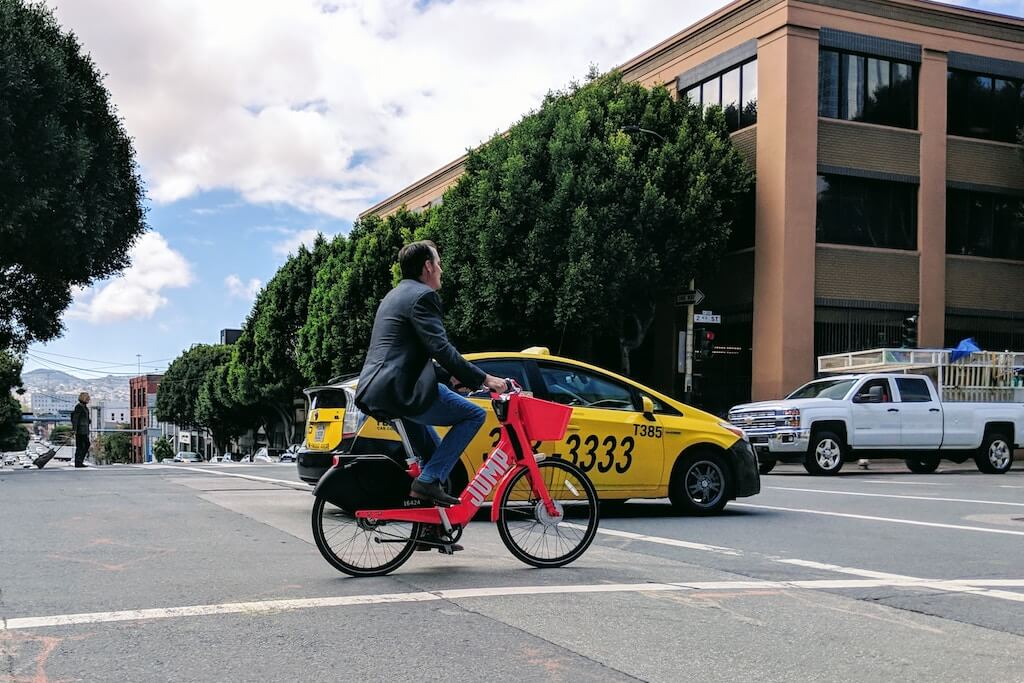Autumn Gear Guide
Find inspiration in our Gear Guide that will keep you out on your bike through wind or rain.
Download NowSan Francisco is a city known for its fancy bridge, vibrant culture, and progressive outlook including a reputation as a city that is friendly to its cyclists and pedestrians. However, it has also grappled road safety and keeping to the goals of its Vision Zero program. In 2022, there were 377 bicycle accidents that were […]
San Francisco is a city known for its fancy bridge, vibrant culture, and progressive outlook including a reputation as a city that is friendly to its cyclists and pedestrians.
However, it has also grappled road safety and keeping to the goals of its Vision Zero program. In 2022, there were 377 bicycle accidents that were actually reported including two fatalities, and more than 60 per cent of those occurred at intersections.
One of the riskiest scenarios cyclists and pedestrians face every day on city streets is at intersections while proceeding through an intersection while watching to see if drivers will actually see them and wait at their red light, or turn right and hit them. Ask a cyclists who has spent more than a few days biking around any city in North America, and they will know just how often it happens.
This seemingly innocuous practice has resulted in a litany of collisions, injuries, and stress for pedestrians, especially children, families, seniors, and individuals living with disabilities. Fortunately, there is a movement underway to transform San Francisco’s streets for the better, through the implementation of No Turn On Red (NTOR) citywide.
It’s a law that exists throughout Europe and in some select North American cities such as Montreal, New York City and more recently Cambridge, Massachusetts. Not surprisingly, cities that offer some of the best bicycle networks and prioritise people instead of cars.
The existing practice of permitting right turns on red lights unless signs explicitly prohibit it has led to significant challenges on San Francisco’s roads. Collisions and injuries have become an unfortunate reality at busy intersections. Moreover, the ambiguity surrounding when it’s safe to cross streets or walk through crosswalks creates a stressful environment for vulnerable road users such as cyclists and pedestrians.
Apparently, the city of Montreal resisted its ban on right turns on red lights in 2017, and according to a news report found that it was “unthinkable to support a measure that creates road insecurity and injuries.”
We love Montreal.
NTOR is not merely a rule change; it’s a proven strategy to enhance safety and predictability for all road users. NTOR regulations have demonstrated remarkable success in increasing safety at intersections. This measure benefits pedestrians by creating a more secure environment, while also offering motorists a more intuitive and predictable driving experience. With NTOR, intersections become safer and more comfortable spaces for everyone, as evidenced by the results of the Tenderloin pilot project.

Luke Bornheimer, who recently campaigned against the center bike lane on Valencia, has been advocating for a No Turn on Red for San Francisco, and has created an online petition garnering more than 5,100 signatures.
“Implementing No Turn On Red citywide will significantly improve to roadway safety, especially for people walking and using mobility devices to cross streets, particularly children, seniors, and people with disabilities,” wrote Bornheimer, in a social media post. “NTOR will also significantly lower people’s stress levels.”
See the thread below that includes a fantastic summary of the issue.
🧵 Thread about No Turn On Red (NTOR), how NTOR can be implemented in San Francisco, and how state legislators can make the implementation of NTOR faster, easier and more affordable.
Support No Turn On Red citywide now in a few taps and less than a minute.https://t.co/zrclZUrMjm
— Luke Bornheimer (LukeBornheimer@sfba.social) (@LukeBornheimer) August 25, 2023
In Fall 2021, the San Francisco Municipal Transportation Agency (SFMTA) initiated a groundbreaking pilot project in the Tenderloin district. More than 50 intersections were equipped with No Turn On Red signs to study the impact on road safety and pedestrian experiences. The findings from a before-and-after study reveal the potential of NTOR restrictions to enhance road safety dramatically:
Motorist Compliance: The project demonstrated that motorists are highly compliant with NTOR restrictions. On average, an astounding 92% of vehicles adhered to the turn restriction.
Close Calls at Intersections: Despite the expected increase in pedestrian-vehicle interactions due to NTOR restrictions, close calls involving vehicles and pedestrians significantly decreased. The number of close calls dropped from five incidents before NTOR signs were posted to just one close call after restrictions were in place at observed intersections.
Crosswalk Encroachment: The project also found that vehicles blocking or encroaching onto crosswalks during a red signal decreased by more than 70% after the restriction was implemented. This promising result ensures that pedestrians can move safely and comfortably through intersections.
Yielding Behavior: While NTOR primarily addresses right turns on red lights, it’s important to note that there was no significant change in the percentage of turning vehicles yielding at crosswalks to pedestrians on a green light.
San Francisco is on the cusp of becoming the second-largest city in the United States to implement a citywide ban on right-hand turns on red lights (after NYC). This proposal has garnered significant support, with advocates arguing that it will make roads safer for bicyclists and pedestrians, encourage more people to walk, and reduce the number of serious injuries in car accidents.
San Francisco Supervisor Dean Preston, a staunch advocate for road safety, introduced this groundbreaking measure at a recent Board of Supervisors meeting. In his impassioned speech, Supervisor Preston emphasized the urgent need for this change: “Allowing turns on red results in deaths, injuries, and collisions, as well as cars blocking or driving through crosswalks, making it more dangerous and stressful to cross the street. We should be expanding no turn on red to every neighborhood.”
The success of the Tenderloin pilot project highlights the need for a citywide implementation of No Turn On Red. San Francisco has the opportunity to make its streets safer, more predictable, and less stressful for all its residents and visitors. The SFMTA has the authority to approve citywide NTOR and install the necessary signs throughout the city immediately, in accordance with state law.

In stark contrast to most North American jurisdictions where right turns on red lights are commonplace, most European countries adopt a strict stance on right turns on red lights. In Europe, a red light means a complete stop, and no exceptions are made for right turns unless otherwise indicated by a specific sign or signal. These strict regulations are grounded in European traffic safety standards, which prioritize pedestrian safety and uniform traffic management.
The primary reasons behind these strict regulations are the densely populated urban areas, narrow streets, and complex intersections prevalent in many European cities. These factors increase the risk of accidents if right turns on red were allowed, as pedestrians, cyclists, and other vehicles often share the road in close proximity.
In the quest to make San Francisco’s streets safer and more enjoyable for all, the expansion of No Turn On Red (NTOR) stands as a promising solution. By eliminating the ambiguity surrounding right turns on red lights, this measure has the potential to reduce accidents, injuries, and stress, while encouraging more people to walk and explore the city. San Francisco is poised to make a historic change, and as the proposal progresses, it signifies the city’s commitment to embracing innovation and prioritizing the well-being of its residents and visitors alike. For more information, please visit [insert campaign website or relevant link].
Find inspiration in our Gear Guide that will keep you out on your bike through wind or rain.
Download Now
Kudos to San Francisco for considering and potentially implementing this law, as it not only reflects the city’s dedication to road safety but also sets an inspiring example for other communities to follow. Creating a safer environment for cyclists benefits everyone and strengthens the sense of community and shared responsibility on our roads.
Comments are closed.